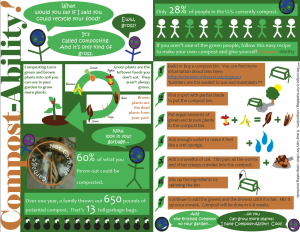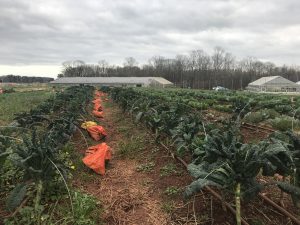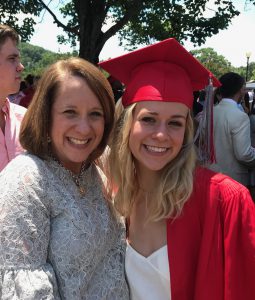Along with many of my classmates, I worked on gathering information and preparing a presentation about composting for the RAs of Rooker Hall. For this project we kept in mind several things: our audience and our objective. Our audience was the RAs of Rhooker Hall and our objective was to inform them about composting and how to do it, so for our research we compiled helpful information that was relevant to this topic. We did not want the presentation to be too technical, so we tried to include only basic details about the benefits of composting as well as what to and what to not compost. After we had enough information, we created a flyer that was colorful, aesthetically pleasing, and easy to read, and we created a PowerPoint presentation to show during the meeting with the RAs. This type of research—keeping a narrow focus based on the audience—will be helpful in the future should I ever give a presentation to a group of peers who are not currently studying or have studied the topic at hand.
During the research project and presentation, we focused on the dos and don’ts of composting, how composting is beneficial, and any common questions we believed our audience might have. Before this project, I knew that composting was good for the environment, but in researching I learned just how large the impact of composting can be. Furthermore, in researching the specifics of what is compostable from different websites, I gained a very precise picture of composting as well as used some of the questions I had prior to beginning the project to help the RAs develop a similar understanding. Presenting the information to people who did not know much about composting also furthered my knowledge about the subject because we prepared to deliver the material, and we were able to hear and respond to their questions.
I thought an interesting component in our presentation was the section about why we should compost. We included several interesting statistics and facts that definitely intellectually stimulated our audience. During preparation for this presentation, we always kept in mind our audience, which is evident in the short but informative presentation as well as the easy to read but interesting flyer we made. I think our creativity was evident in both of these elements, as we made sure to cater to our audience in an interesting and pleasurable way.
Reflecting about the presentation, I learned that I can remain calm despite pressure. Right as we were about to give our presentation, we ran into some difficulties with our location, so we ended up having to move to a different room where there was no projector. Despite this mishap, my peers and I pulled together and kept level heads. I also thought that I did a better job of paraphrasing the information on the slides than I have in the past, and I do see myself as more confident since we delivered a good presentation on the fly and were able to respond to questions.
Most of our project was centered around our assumption that only a select few people want to listen to a lengthy and technical presentation about composting on a Wednesday night, and that the Rhooker Hall RAs were not among those few. Consequently, we made our presentation brief and straightforward, and we made the flyer engaging and simple. For future communication efforts, I will seek to find a balance between achieving the goal of the presentation and being sensitive to the proximity of the audience to the subject.
If I could change something about our presentation, I would have prepared more thoroughly so that we could have adapted better to the switched order of the presentation. Nonetheless, the presentation taught me that people are more interested in composting than I had previously thought and that composting is a very marketable as well as an important activity. The presentation also helped me with teamwork, which is common in this course, and my presentation skills. I learned that a crucial presentation skill is keeping your audience in mind as well as being engaging, and I learned that feedback from professors and other faculty members involved is crucial as well. All of these skills and tools will be useful both in my education at the University as well as in my professional field after graduation.
As a group, I felt we had a strong grasp of our information. However, we did appear slightly frazzled, as the location change and segue to the project threw us off. I would have preferred for us to appear more put-together, but the situation did not aid us in that pursuit. I do believe that, in sum, we came across as knowledgeable which was beneficial in marketing our project to the audience. Furthermore, I think giving this presentation was effective because it developed my group work skills as well as my communication skills, both of which are vital for both academic and professional success. I felt my classmates and I received helpful feedback that led us in the right direction, and, ultimately, I believe our presentation was a success.



